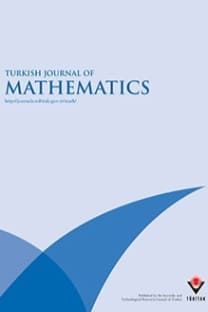Analysis of a differential equation model of HIV infection of $CD4^+$T -cells with saturated reverse function
Analysis of a differential equation model of HIV infection of $CD4^+$T -cells with saturated reverse function
___
- [1] Brauer, F.: Backward bifurcations in simple vaccination models, J. Math. Anal. Appl. 298, 418–431 (2004).
- [2] De Boer, R.J., Perelson, A.S.: Target cell limited and immune control models of HIV infection: A comparison, J. Theoret. Biol. 190, 201–214 (1998).
- [3] Essunger, P., Perelson, A.S.: Modeling HIV infection of CD4 T-cell subpopulations, J. Theor. Biol. 170, 367–391 (1994).
- [4] Gantmacher, F.R.: The Theory of Matrices, Chelsea Publ. Co., New York, 1959.
- [5] Hirsch, M.W.: Systems of differential equations which are competitive or cooperative, IV, SIAM J. Math. Anal. 21, 1225–1234 (1990).
- [6] Kepler, T.B., Perelson, A.S.: Cyclic re-entry of germinal center B cells and the efficiency of affinity maturation, Immunol. Today 14, 412–415 (1993).
- [7] Kirschner D.: Using mathematics to understand HIV immune dynamics, AMS. Notices, 43, 191–202 (1996).
- [8] Levy, J.A.: HIV and the pathogenesis of AIDS, Washington DC: ASM Press, 1994.
- [9] Liu, W.M., Levin, S.A., Iwasa, Y.: Influence of nonlinear incidence rates upon the behavior of SIRS epidemiological models, J. Math. Biol. 23, 187–204 (1986).
- [10] Martin R.H., Jr.: Logarithmic norms and projections applied to linear differential systems, J. Math. Anal. Appl. 45, 432–454 (1974).
- [11] McLean, A.R., Rosado, M.M., Agenes, F., Vasconcellos, R., Freitas, A.A.: Resource competition as a mechanism for B cell homeostasis, Proc. Natl. Acad. Sci. USA 94, 5792–5797 (1997).
- [12] Muldowney, J.S.: Dichotomies and asymptotic behaviour for linear differential systems, Trans. Amer. Math. Soc. 283, 465–584 (1984).
- [13] Muldowney, J. S.: Compound matrices and ordinary differential equations, Rocky Mountain J. Math. 20, 857–872 (1990).
- [14] Nowak, M.A., Bonhoeffer, S., Shaw, G.M., May, R.M.: Anti-viral drug treatment: dynamics of resistance in free virus and infected cell populations, J. Theor. Biol. 184, 203–217 (1997).
- [15] Ouifki, R., Witten, G.: A model of HIV-1 infection with HAART therapy and intracellular delay, Discrete Cont. Dyn-B 8, 229–240 (2007).
- [16] Percus, J.K., Percus, O.E., Perelson, A.S.: Predicting the size of the T-cell receptor and antibody combining region from consideration of efficient self-nonself discrimination, Proc. Natl. Acad. Sci. USA 90, 1691–1695 (1993).
- [17] Perelson, A.S., Essunger, P., Cao, Y.: Decay characteristics of HIV-1-infected compartments during combination therapy, Nature 387, 188–191 (1997).
- [18] Perelson, A.S., Nelson P.W.: Mathematical analysis of HIV-1 dynamics in vivo, SIAM Rev. 41, 3–44 (1999).
- [19] Smith, H.L.: Monotone dynamical systems: An Introduction to the theory of competitive and cooperative systems, Trans. Amer. Math. Soc. vol. 41, 1995.
- [20] Smith, H.L.: Systems of ordinary differential equations which generate an order preserving flow, SIAM Rev. 30, 87–98 (1998).
- [21] Smith, H.L., Zhu, H.R.: Stable periodic orbits for a class of three-dimensional competitive systems, J. Differential Equations 110, 143–156 (1994).
- [22] Song, X.Y. and Neumann A.U.: Global stability and periodic solution of the viral dynamics, J. Math. Anal. Appl. 329(1), 281–297 (2007).
- [23] Srivastava P.K., Banerjee, M., Chandra, P.: Modeling the drug therapy for HIV infection, J. Biol. Syst. 17, 213–223 (2009).
- [24] Srivastava, P.K., Chandra, P.: Modeling the dynamics of HIV and CD4+ T cells during primary infection, Nonlinear Anal. RWA 11, 612–618 (2010).
- [25] Thieme, H.R.: Persistence under relaxed point-dissipativity (with applications to an endemic model), SIAMJ.Math. Anal. 24, 407–435 (1993).
- [26] Zack, J.A., Arrigo, S.J., Weitsman, S.R., Go, A.S., Haislip A., Chen, I.S.: HIV-1 entry into quiescent primary lymphocytes: molecular analysis reveals a labile latent viral structure, Cell 61, 213–222 (1990).
- [27] Zack, J.A., Haislip, A.M., Krogstad, P., Chen, I.S.: Incompletely reverse-transcribed human immunodeficiency virus type 1 genomes in quiescent cells can function as intermediates in the retroviral cycle, J. Virol. 66, 1717–1725 (1992).
- [28] Zandrea Ambrose, John G. Julias, Paul L. Boyer, Vineet N. KewalRamani, Stephen H. Hughes, The level of reverse transcriptase (RT) in human immunodeficiency virus type 1 particles affects susceptibility to nonnucleoside RT inhibitors but not to Lamivudine, J. Virol. 80, 2578–2581 (2006).
- [29] Zhen, J., Haque M., Liu Q.X.: Pulse vaccination in the periodic infection rate SIR epidemic model, International Journal of Biomathematics 1, 409–432 (2008).
- [30] Zhou, X.Y., Song X.Y., Shi, X.Y.: A differential equation model of HIV infection of CD4+ T-cells with cure rate, J. Math. Anal. Appl. 34, 1342–1355 (2008).
- ISSN: 1300-0098
- Yayın Aralığı: 6
- Yayıncı: TÜBİTAK
Some results on g-frames in Hilbert spaces
Abdolaziz ABDOLLAHI, Elham RAHIMI
Multi-dimensional Weiss operators
Yaşar POLATOĞLU, Sergey BORISENOK, M. Hakan ERKUT, Murat DEMİRER
Cyclic codes over $Z_2 + uZ_2 + u^2Z_2 + . . . + u^{k−1}Z_2$
Mohammed AL ASHKER, Mohammed HAMOUDEH
A Beurling-type theorem in Bergman spaces
GPQ modules and generalized Armendariz modules
A class of generalized Shannon-McMillan theorems for arbitrary discrete information source
Geometrical objects associated to a substructure
Mircea CRASMAREANU, Fatma ÖZDEMİR
Zahra POORMAHMOOD, Reza NIKANDISH, Mohammad Javad NIKMEHR
The cyclicity of the period annulus of a quadratic reversible system with one center of genus one
